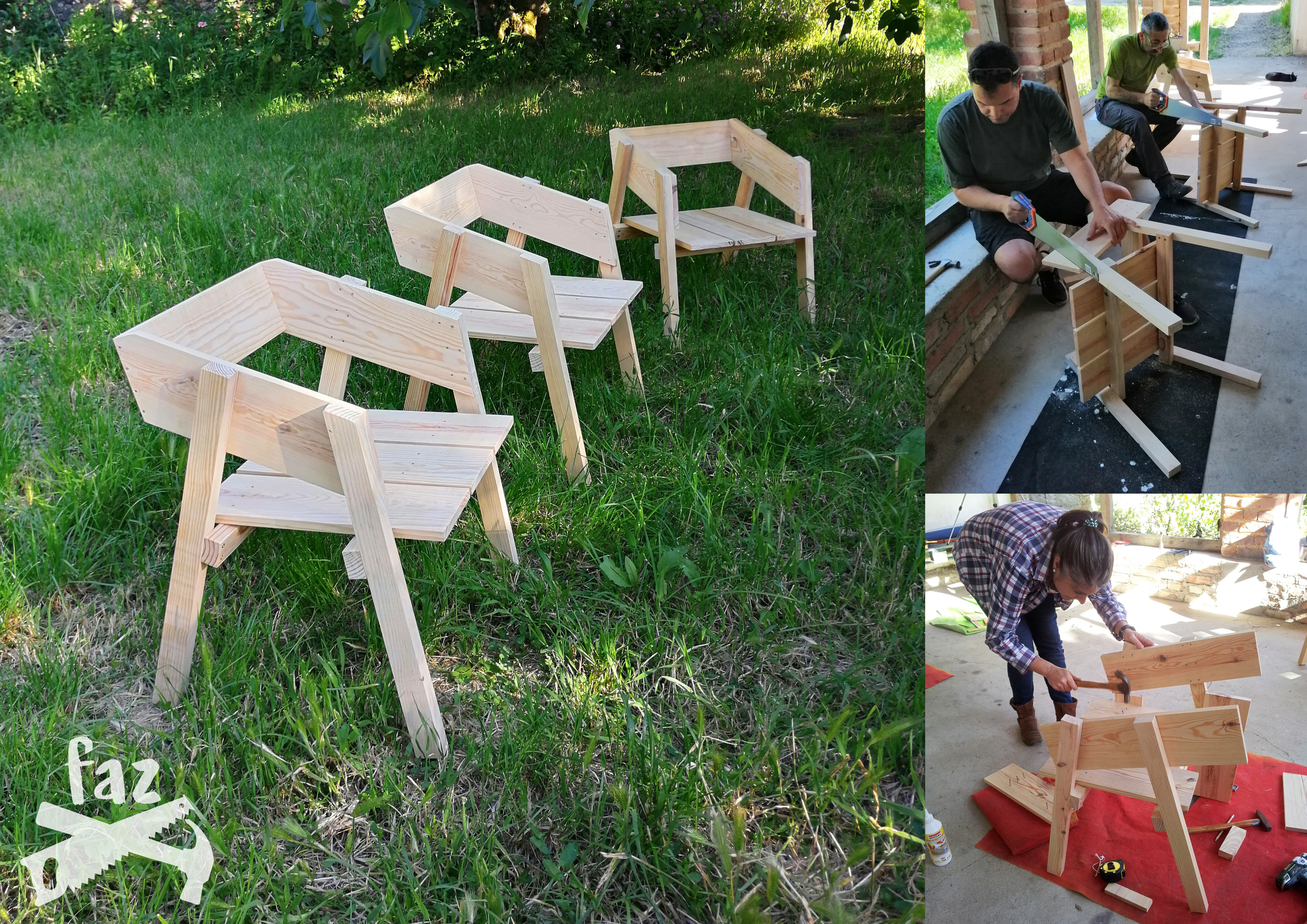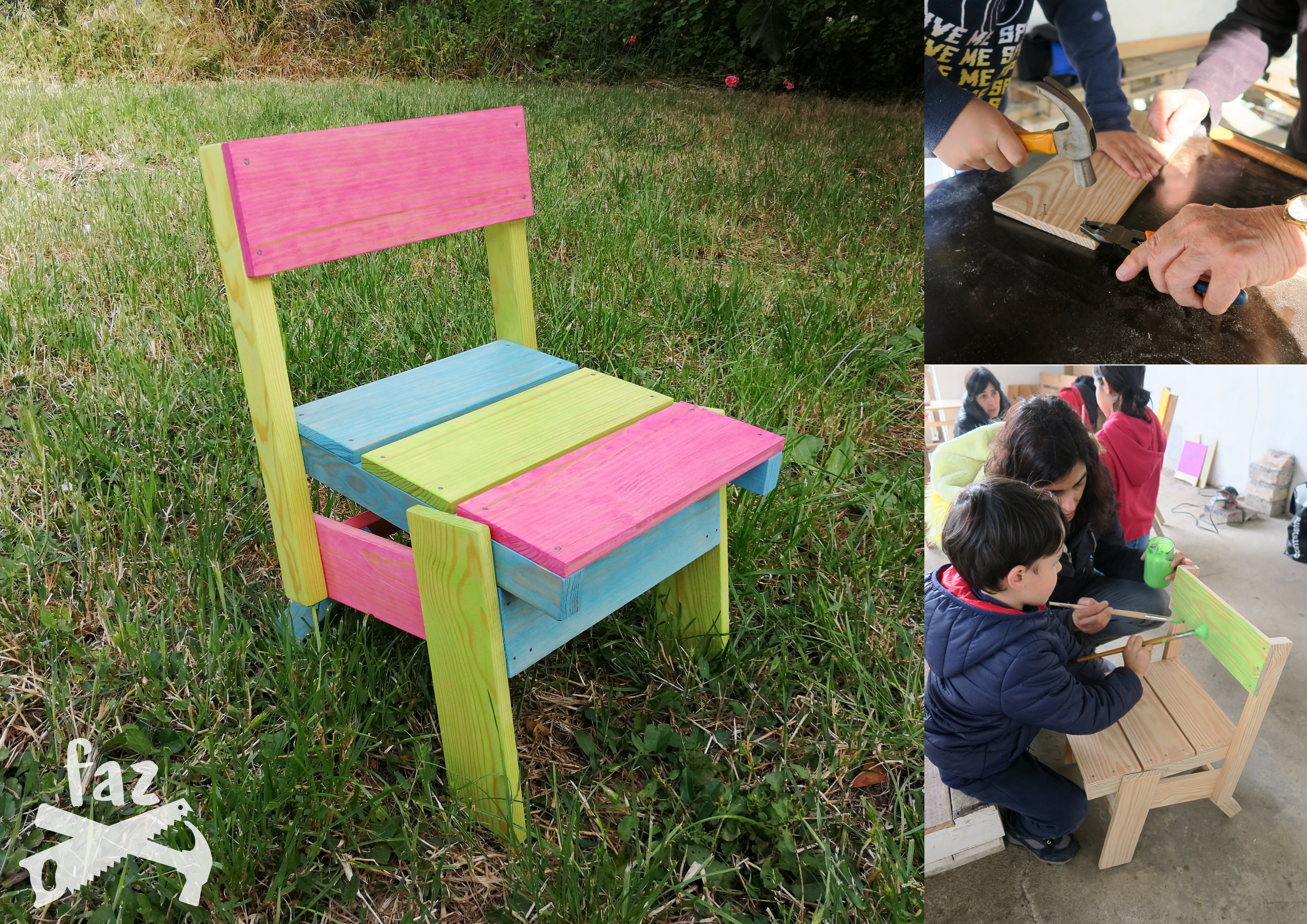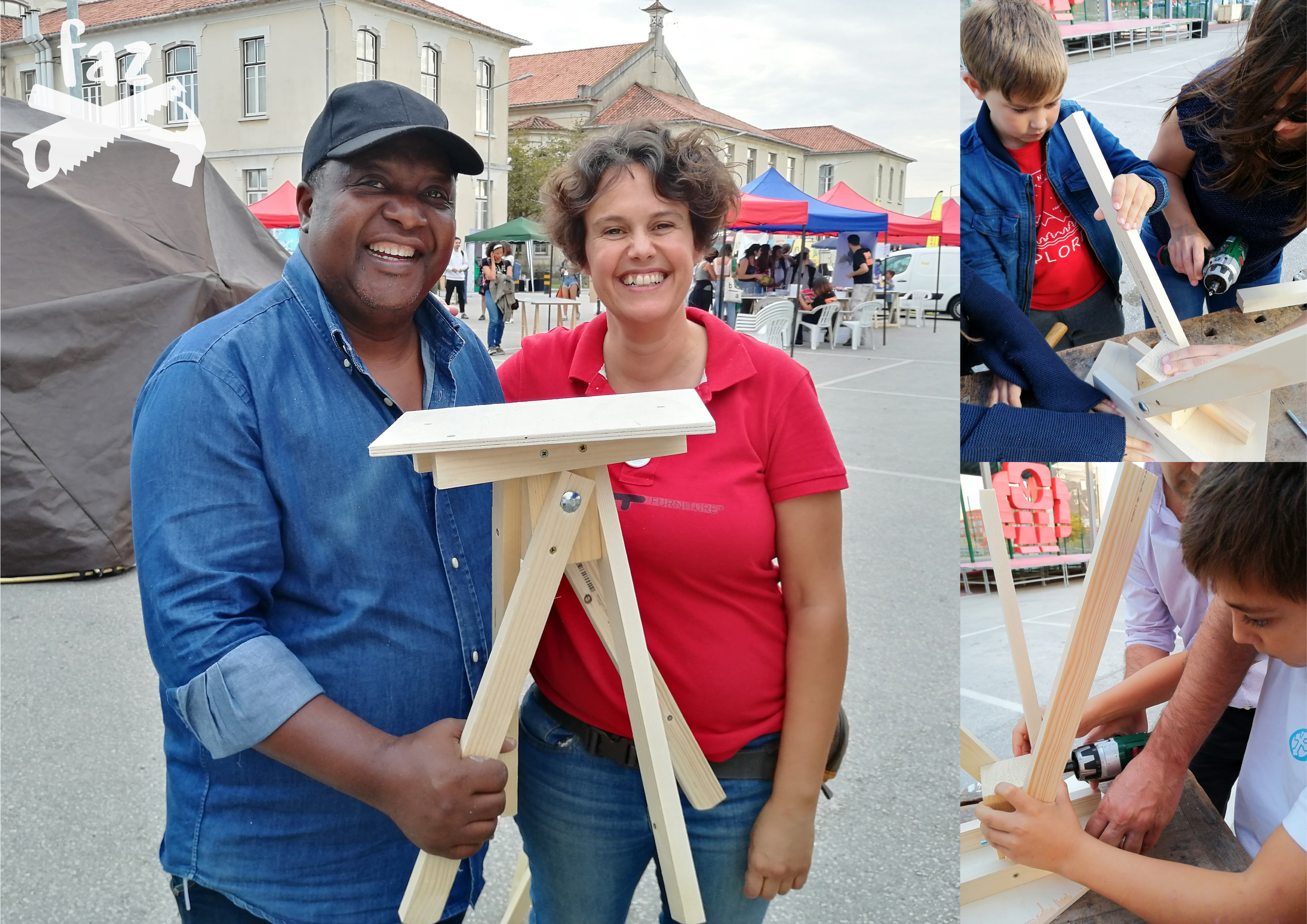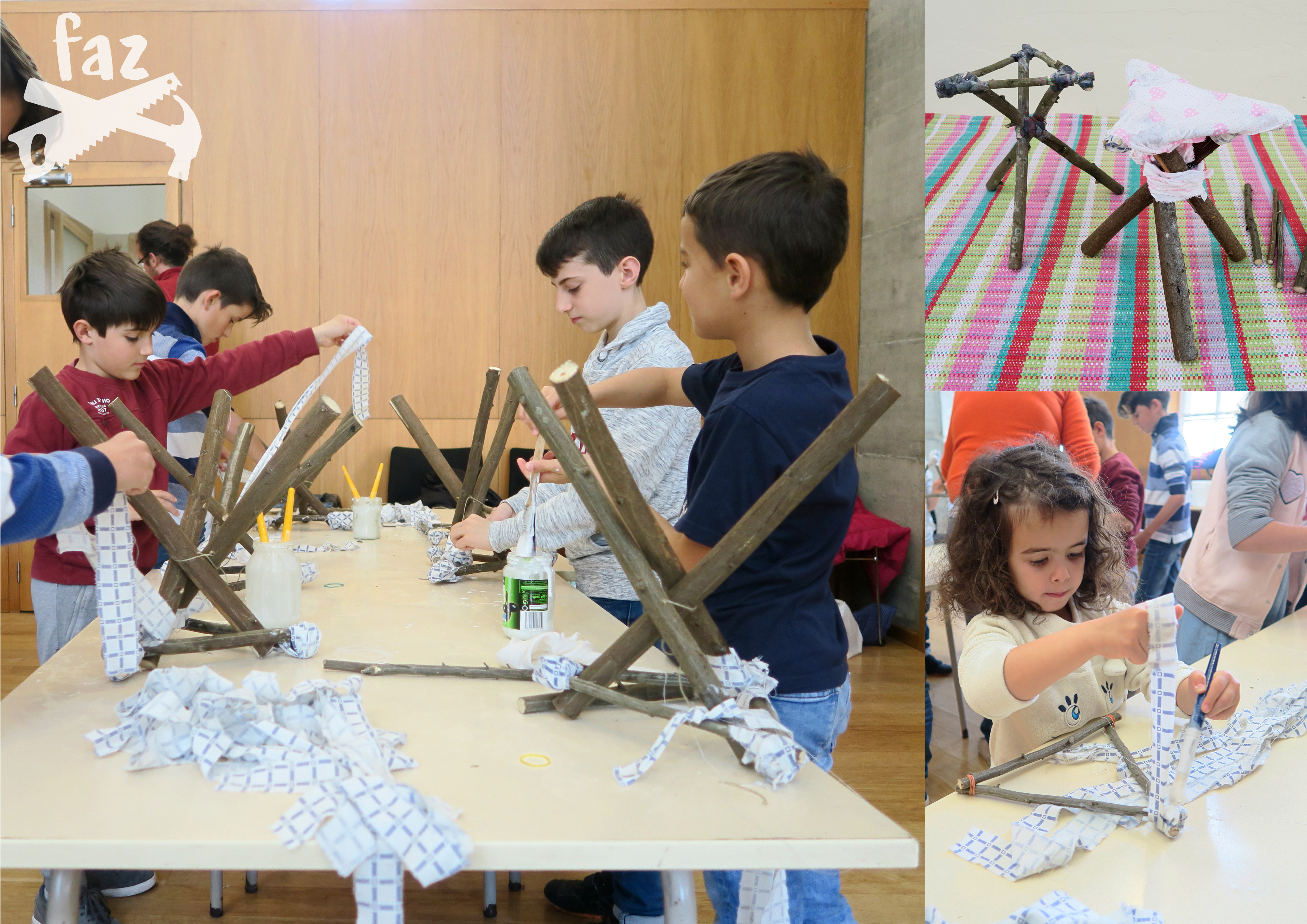The revolution in manufacture is happening, design is at service of user-makers:
DO IT with your hands (FAZ com as tuas mãos)!
Change your mindset: everyday use products don't have to be made by industry. FAZ are easy to build designs and classes to demystify wood furniture making and empower people to do their own. Each piece is designed to be easy to build, with basic tools and easy-to-find materials.
Your handwork provides more gratification than mass-produced goods consumption.
FAZ com as tuas mãos (DO IT with your hands) is a participatory process to produce furniture pieces. I have designed easy to make furnishes, with easy-to-find materials and basic tools and teach people how to do them.
Maybe furniture doesn't have to be made by industry, woodworking doesn’t have to be joinery, nor about wood composites with “perfect” finishes. Maybe if we just go a step back and take a modest and simpler approach, we can make something new: democratize access to furniture made by users.
FAZ challenge is to produce locally, with whatever is available nearby, prefer renewable, biodegradable, low carbon footprint and/or from circular materials, use basic and generalized use tools, empower people to do it themselves and share designs. In this sense, I designed a chair, a stool, a bench, a table, children's chair and table, kids classroom furniture, playground objects and toys that balance functionality and aesthetics with self-building values. Each piece is made of: 2 or 3 different references of local pine wood; used palettes and any raw or reclaimed planks; standard worldwide retailer cutted wood; or just free growing twigs of invasive species.
Workshop classes happen regularly, some are for adults, other for children, same for both and others for communities.
Each piece of furniture is built by a sum of fractions using simple overlap and triangulation to steady the furniture, and fixed with nails, screws and PVA glue. Use a screwdriver and hammer to assemble parts, in some cases, short cuts with a handsaw, others are simply brushed with PVA reinforced with old cotton fabric. Participants make a piece in between 30 minutes to 6 hours, and take a ready to use piece of furniture home or contribute to equip a community place.
The gratification of doing something with our own hands increases self-esteem. The fast and easy approach to woodworking experienced in the FAZ workshop reveals DIY as a real and desirable alternative to shopping.
Please highlight how the project can be exemplary in this context
The production-distribution-consumption chain is broken. Exchange to: local materials, all-over available tools and production on demand. In order to feed mass consumption some production workforce lives in degrading conditions; low quality materials are used and the entire chain is dependent on fossil fuels. I don’t want to make part of it:
As a participatory process, if you want a FAZ piece of furniture you have to premeditate its acquisition by registering for a workshop. You are involved in the whole process and thus affectively connected to the piece you built. You don't discard it easily.
Materials are easy to find in the exact amount, from local sources or by just upcycling what is available. Mostly, I chose wood because it is a nearly universal material, very easy to work with and with a fantastic height-toughness relation. If you choose just the one from local responsibly managed forests, it is a low emissions material. Beyond that, it is very appropriate to source it from upcycles, such as pallets or boards from building demolitions or old furniture. Another "green" material that I am looking to use more and more are the branches of invasive plants such as acacia (melanoxylon) and cane (Arundo donax).
Fittings are: nails, screws, PVA glue and/or pieces of used cotton fabric.These are chosen by the racio: fixture capacity - application easiness and amount of emissions. In that sense, steel connectors were discarded, because metal production has a lot of CO2 emissions. To stabilize a piece of furniture you can simply use the right design.
Regarding the end of life of each piece, the users are also its builders and during their training they receive the knowledge to make repairs. They are also encouraged to only use biodegradable finishes like linseed oil or to simply leave it "natural". In addition to each piece being compostable, it can also be used as fuel in a fireplace, as its burning does not emit dangerous compounds.
Please highlight how the project can be exemplary in this context
How to offer a real alternative to buying furniture?
We live in a society with a wide range of object choices to reach the same functionality. An alternative has to be as appealing as those. For that goal I have designed the pieces in a clean and contemporary aesthetic, very honest in the way it is built, with enough character to be constituted as a brand. This, with the aim of creating objects of desire, boosting people's attention and participation. Most participants are attracted by the bold and original FAZ designs. Some even believe that they are investing in a signature design piece.
FAZ is more than an object, it is an experience.
FAZ com as tuas mãos is not just a set of easy to do furniture models, are workshops for beginners. A participatory learning model creates an immersive experience of how easy, fast and gratifying this handwork is. In the workshops, participants experience how feasible these furniture pieces are to make. In the design phase, each decision in the form of the piece of furniture is made taking into account the difficulty and time of each operation, as well as the level of expertise of the participants. These are designed to be enjoyed to build. Each piece takes between 30 minutes, in the case of the stool, to 6 hours, like the armchair, to be made. Techniques in use are fast and easy learning curve, therefore you feel instant gratification by the immediate results of having a ready to use piece of furniture. Furthermore, the gratification of doing something with our own hands increases self-esteem.
Please highlight how the project can be exemplary in this context
FAZ production methods were chosen for their accessibility in means of equipment and skills. To become a widespread practice, making our own furniture has to be as accessible as knitting yourself a piece of clothing: no special installations are needed, everyone is invited, there are classes for all ages and you can easily have size custom made pieces.
Wood has an excellent cost - efficiency ratio, compared with metal or plastics to make furniture. Apart from that the tools are cheaper to purchase. The wood used in FAZ workshops is pine from local sources, but it can be any other cheap softwood. With the goal to make it as accessible as possible, I'm investigating the use of free materials, like the Acacia twigs (an invasive specie) that I already use in the stool children's workshop. In the workshops where the furniture isn’t meant to be transported, upcycling pallets is a very cheap option.
The chosen tools to each workshop depend on the size and age range of the group, taking in consideration safety, adequacy of tasks to motor skills and attention needed to teach the techniques. Children are in focus at FAZ because they are an essential part of the mindset change that is intended to a less carbon emissive lifestyle.
Some FAZ workshops are designed for a common benefit (beyond the ones that each participant makes a piece to take home). In these, people are involved in identifying needs and building solutions. Is the case of the “MAKE a happy school” workshop (see citizens involved field).
Other, quicker workshops are designed for institutions to offer to the public to participate, those are paper kite construction, cereal box cardboard toy mask, the fast stool and the twigs stool workshop. In this one, I have a large group of unaccompanied children in ages that don’t master knots and a super low budget. Therefore I opt for school available tools: brush and scissors, and free materials: twigs and upcycled cotton fabric.
Please highlight how this approach can be exemplary
Before FAZ, I managed 3 own product brands and worked in the industrial sector. The struggle to prevail over the competition left me exhausted: finding a manufacturer and a raw material on the scale of our investment; design a desirable product for these specifics; distribute to resellers, who have to, at least, double the article price, to meet the costs of having a point of sale; and thus the product to be bought for 4 to 5 times the cost price - all this becomes for me an absurdity. So I said to myself - "There has to be a better way to give people what I'm passionate about!". The job I enjoyed the most was teaching university students to build their prototypes and giving them the gratification of making an object "with their own hands" - that's what I'm going to do! And FAZ was born.
As you can see from the logo, FAZ proposes to be disruptive with the consumption system, a “pirate” in the goods industry. No suppliers (almost), no subcontractors and no distributors. What is left? The most important - people. And since it is not possible to survive on a planet of greedy and self-centered people, ecological sustainability is equally important.
So, you can have a chair without hidden procedures, in which you can easily get to know all the "faces" involved from the raw material to the final piece. Today's design cannot ignore the ecological impact of a product: How far raw materials came from? What are the environmental impacts of the production process? How much did it travel to be distributed? Is the product easy to repair? And the end-of-life, is it possible to value the product materials? In addition to answering these questions, design must also balance attractive aesthetics, with ergonomics and build quality. FAZ chair does! And by skipping the intermediaries, its price also competes with mass-produced chairs. Along the way you learned something new and had a really fun social time.
FAZ com as tuas mãos is led by a single person: I’m the product designer-maker-teacher-marketer. I’m graduated in Product Design, taught at the University and worked in different industries. I have always manufactured my designs from handcrafted to digital technologies. I launched FAZ in October 2018, since then, I have developed 13 different workshop models, with 21 different product models, in 32 events, 144 pieces have been made by more than 200 participants.
FAZ is a set of principles to divert people's attention from consumerism, offering a viable alternative to satisfy the need for new goods. Along the way, people discover a rewarding activity. They take a more sustainable path, becoming more aware and active citizens in a greener economy. And in this sense I can say the impacts are:
Shifting from "buy" to "do it"
The good quality of the objects built in the workshops means that, at the time of the purchase decision, the option of a DIY object is considered by most of the participants. People choose to offer a workshop sign up than to buy gifts. Some ask to redesign models to their needs or available materials. Others make classes at their places as a way to furnish and as a social event.
Handwork to self-esteem
The gratification achieved by the participants is almost additive, they repeat the experience. A big part of them have started making woodworking after the classes. Some repeat workshops to make different models, or even, the same one, again.
Prefer local
Orders for my woodwork have increased, people value buying something locally produced by an artisan rather than buying a cheap item on the internet.
Value materials
“A discarded board is a find”, the participants of the workshops look at the waste materials as an opportunity: "What can I do with this?". Workshop participants value the pieces they made much more than the ones they buy, they do not easily discard them because they create an affective relationship due to the whole experience.
Please also explain the benefits that derived from their involvement.
With FAZ workshops citizens and organizations have been able to equip themselves at a lower cost than to buy equivalent market offers. In addition they benefit from the social event itself: a group of people with the same interest get together to be productive. The individual participant workshops are organized to be in a very relaxed ambience: a small group joins on the weekend, no noisy or dangerous tools are used, lunch is a chill out social time, and, at the end of the day, you take home the reward of your work.
This experience changes the way participants value simple materials, transforming them into stylish pieces, with few technical resources and in a short time, is revealed as an alternative to mainstream consumption. People feel encouraged to create their own designs inspired by the simple way FAZ models are built. Also, teached by the example, people choose low footprint materials. The shift is made: workshop participants are now agents in making things instead of just non-critical consumers.
Other models of workshops are meant to benefit institutions. Designed to be built in community, where participants contribute by volunteering. The FAZ pallet bench is an example, designed to furnish a community garden with the aid of their users, people trade their work for the benefit of all and in return learn how to make it.
Other examples are a playhouse, a children table, a balance labyrinth and a sandbox that were designed to be made by a group of parents for their children's school. A wholesaler was pleased to offer tools and materials as part of his social responsibility, a transportation company offered a bunch of pallets, city council and a local association made the marketing. It took one day of work, teachers, functionaries, parents, family, friends and children, all together, contributed to the benefit of the school playground. The sense of joy, pride and self empowerment are main factors to make this community more resilient.
We live in a world of super-performing products, in infinite variations, available in a range of prices for the convenience of a “click”. By the way, we're creating brutal amounts of waste that we can't handle. All this easeness isn't avoiding a feeling of overload that we've all felt at some point. Meanwhile, a growing group of people are seeking slow-life in a minimalist lifestyle closer to the zero-waste ideal.
We have to review what is truly important for our lives, reduce the amount of products we consume allowing the rest of humanity to live in dignified conditions and ensure Earth survival. A significant part of our well-being comes from socializing and feeling productive. We could simply "fill" all the products needed in our daily lives with more enriching experiences than simply “going to the mall”: “This beanie was knitted by my mam”; “This second-hand dresser was painted with my husband for my daughters' “; “This cutting board was made at the workshop where I met my friend”... If you have painting classes in your city, why not take classes to do really useful stuff? Design can rethink and adapt the process of producing objects to a more manual way. FabLabs did it on a technological basis, they teach you how to repair electrical appliances! Can you believe it!?
Like FabLabs, I chose a small business model replicable worldwide. The FAZ models are documented in a universal format and can be licensed for use by other trainers to teach at their locations. Transferability and replicability are also guaranteed by the minimum requirements of the facilities needed to build the FAZ pieces.
Material choices also address the challenge of “going greener”: the pine trees from the wood I use grow less than 100km away from where I’m established. The kite sticks and stool twigs are invasive species that grow on the side of the road. Cereal box cardboard toy mask and pallets for the communitary workshops make part of an endless and universal source of materials: garbage
In FAZ the innovation is the process to use design practice tools to conceive objects, not for industry, but to a different approach to produce everyday things. We have come detached from the way things are made because of the super offer of affordable goods. In some cases, either because of the nature of the technique involved, or because of the easy access of the materials, industry didn’t leave in oblivion the artisanal way to do things. Sewing clothes is an example. Unlike it, woodworking hasn't been very present as an option to be self-made.
Now society tends to take a step back because of the ecologic emergence awareness or just because we are saturated with meaningless goods. There is a trend to search for objects with craft value and a behind story. In this sense, DIY culture became very popular because of its affordability and people's desire of self-fulfillment in decelerating hobbie activities, fortifying their freedom and autonomy.
Despite the huge offer made available on the internet, DIY projects tend to be aesthetically unappealing. I struggle myself to find one there I’ll like to have. In FAZ com as tuas mãos designs I look for a compromise between aesthetics, functionality and the particular way these objects are made, I try not to offer just another crafty DIY idea from Youtube, but an elegant piece suitable to be on sale in a design boutique.
Considering the woodworking techniques, the innovation of FAZ is quite subtil, maybe it is just a compromise that we haven’t been able to do: we can compromise the durability of a piece of furniture in solid wood to embrace the ease of construction. We can do this, as long as we are not creating problematic waste, as is the case of short-lived furniture made of melamine-coated wood particle boards.
Woodworking courses tend to be intensive and in traditional practices, at another side there are the enthusiasts for digital tools, FAZ offers a more affordable, instant and ready to use day-by-day solution.
Please provide clear documentation, communication of methodology and principles in this context.
Who could have anticipated that there are so many inexpert people willing to try a seemingly difficult technique? Who would have thought that parents lead children to use tools?
What other techniques are waiting to be adapted to a more participative production process? Imagine a catalog of creatives with different aesthetics where we can choose the piece that most appeals to us. Why not a product brand that doesn't sell goods, but teaches you how to make them? What if instead of a production point that distributes to many points of sale, we had places in our community where we can go to make the piece we need, like the FabLabs? We could just distribute the knowledge of how to do it. It could be a network of individual appropriations and local adaptations in order to exponentially evolve into: greener materials; wider source of circular materials; alternatives for unavailable tools; other techniques; bigger range of objects; different aesthetics; and useful documentation to replicate workshops. Available platforms such as Wikifactory, Maker Movement and Distributed Design Market Platform can be used.
Different types of local businesses can born from this buzz: suppliers of raw materials, training places, articles exhibition and even selling points may be all available on an address map.
How is the I&D sustained?
FAZ designs are original, authorial and free to use (CC BY-NC-ND 4.0). Workshop participants are encouraged to share the building instructions with friends. When the pieces are built for commercial purposes a royalty is requested. As in cultural activities, financial returns may not be immediate or obvious, some chances are: donations from Patreon or Crowdfunding, workshops fees, design consulting and product sales.
Who could guess that a single person, without budget, or support, in 3 years, and with a pandemic in between, could put more than 200 people to produce objects alternative to consumer goods? What can this become with the right support?






@MarianaCosta e Silva, 2021
Content licensed to the European Union.